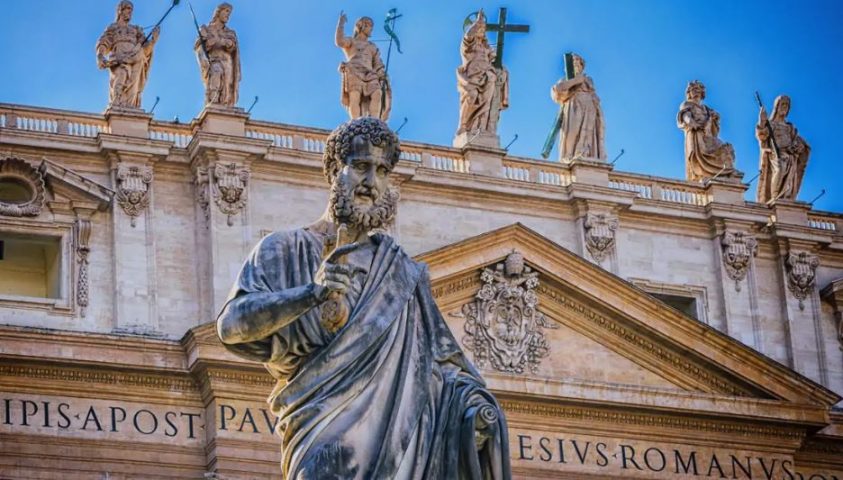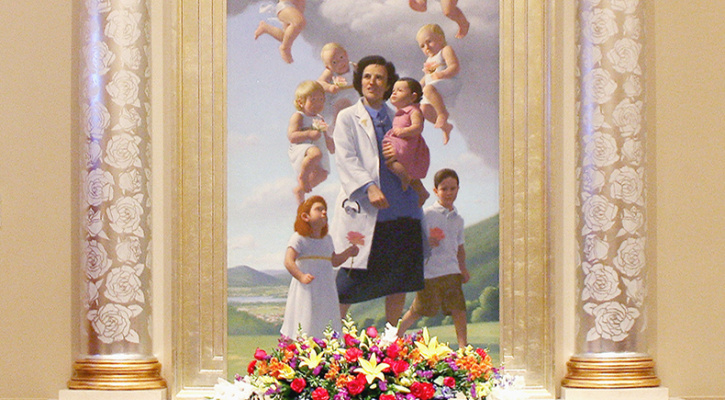Rev. Paul D. Scalia: Sacred Architecture and the Meaning of Community

Satanic Temple Loses Abortion Religious Freedom Case in Missouri
February 15, 2019
On Belief Without Faith, by David Warren
February 15, 2019
By Rev. Paul D. Scalia, Christendom College

Most Sundays I celebrate Mass at Saint Raymond of Peñafort Parish in Springfield, Virginia. During the Liturgy of the Word, as the priest is at the chair, I find myself gazing at the enormous, beautiful stained-glass window in the north transept, opposite the priest’s chair. The window depicts the Church triumphant—the Lamb of Revelation and our Lord appearing in glory, surrounded by saints of various times and walks of life. However, it is the side panels that speak more to our purposes here.
On either side of the large window are three panels presenting God as a master builder. Beginning on the left, the windows show, first, God creating the world; then King David praising the Lord; and King Solomon supervising the building of the Temple. Continuing on the right is,
word. “And God said” is the constant refrain in the first chapter of Genesis. By His word God not only brings all things into being, He also by that word distinguishes them and sets them in order: light and darkness, heaven and earth, earth and sea, sun and moon, birds and fish, animals and men, man and woman. He sets limits for each and thus gives each a particular role and indeed meaning in creation. Through the Logos He creates a reasonable, rational world.
One point to note in this regard is how the limits that God places—the manner in which He designs each thing for a particular place—bring about meaning. Or, put differently, meaning requires limits. Chesterton once observed that all thought, like all great art, begins with the drawing of a line. To think—to discern the meaning of things—requires us to delineate and distinguish, to say this is not that. Indeed, to define a word—that is, to state its meaning—is precisely to describe its boundaries and limits, to say that it is confined to this specific thing, and not that over there. Those who will not have limits will also not have meaning. All of creation is charged with meaning precisely because God has by the Logos set limits upon it and its inhabitants.
The second essential in the work of the Sacred Architect is the body—by which I mean the entire physical dimension in general and the human body in particular. He created both the invisible—that is, the incorporeal—and the visible. He created heavenly bodies, bodies of water, animal bodies, and—as the summit—man’s body. “Then the LORD God formed man of dust from the ground, and breathed into his nostrils the breath of life.” And later we hear that “the rib which the LORD God had taken from the man he made into a woman” (Gen. 2:7, 22). The physical world in general and the human body in particular are good because they come from the deliberate choice of a free and loving God. The body—the physical dimension—is one of the limits placed on creation and thus one of the sources of meaning.
Third is community. “Then the LORD God said, ‘It is not good that the man should be alone’” (Gen. 2:18). The community that begins with the union of man and woman comes as a blessing directly from the hand of God. He creates us as intrinsically relational. Community for us is not a concession or surrender but a means of realizing our fulfillment, the happiness proper to us. God’s entire construction is meant to be the place—the temple—where He is glorified by man not as an isolated individual but as a community, a body. The creation narrative culminates not in an individual or even a group of them, but in the human family: “Therefore a man leaves his father and his mother and clings to his wife, and they become one flesh” (Gen. 2:24).
All of this God creates for the purpose of worship. Creation is the outward manifestation of His glory, and all elements of creation proclaim his praise. The structure and language of the first chapter of Genesis is that of constructing a temple. It teaches not only how the world came into being but also why. The command given to Adam in the second chapter of Genesis—that is, “to till and to keep” the garden—is the same as given to the priests of the temple in Jerusalem. The world is God’s temple—the place of worship—and man is his high priest.
The word, the body, and community. These characterize the work of the Sacred Architect. They also characterize how man—the image of God—designs and constructs. Regarding the word, first of all, man does not bring things into being by his word. But he does construct with and according to his words. God gives to Adam the power to name the animals, which speaks of the divine prerogative granted to human speech. We have the capacity by our words to shape thought and the proper view of the world, the power to articulate reality.
As I mentioned, it is limits that give meaning. By our words we establish and describe limits and so give meaning to the world around us. That is, we articulate the meaning that we perceive. By our words we describe reality; we draw lines and delineate; we give structure and purpose to things. Our words established the limits that give meaning; they are the way we draw a line and thus begin thought.
Now, nothing speaks of what we think quite like what we build. The mind of the maker is always evident in his works. The study of art should inculcate an appreciation of art for art’s sake. But it should also—especially in the study of the great buildings of history—provide a lesson in the history of thought. The wisdom of the Greeks and the order of the Romans are on display in their buildings. Unfortunately, so also is the will to power of the fascists in mid–20th century architecture.
We likewise form and shape our society according to truth—or, more accurately, according to what we think is true. Our words delineate or trace out what is true about God, man, society, creation, and so on. Laws, legends, a culture’s literary tradition—all these go into shaping the society itself. One of the most beautiful phrases in the Mass expresses this well: divina institutione formati. We are “formed by divine teaching.” It is the word of God, His teaching through the Church, that shapes each of us and all of us as a body. The word has that power to construct.
Second, like the divine Architect, we design and build according to the entire person, soul and body. Or, again, according to how we understand the body. Words are not enough for us; our bodies speak as well. Some psychologists claim that most communication is by way of the body. Whatever the statistics, it is true that the body is another way we give meaning. The Christian martyred in the arena, the soldier jumping on a grenade, the monk kneeling in prayer—these all give meaning to a situation without the utterance of a word.
The reason we find ourselves comfortable and at peace in a beautiful church is not just a matter of aesthetics. Such a building rises from a faith that places great emphasis on the body, that rests upon the belief that God did not overwhelm but in effect proportioned Himself to man—even to the point of assuming a human body. Although a church is built for divine worship and with a supernatural outlook, it is—or ought to be—on a human scale. It is respectful of the human body. Contrast that with the 20th century’s brutalist architecture that displays a coldness, indifference, even an animosity towards the body.
So also our understanding of the human body will determine how we shape society. It is not just a quirk of history that hospitals arose in Christendom. The Christian understanding of the body as sacred shaped a society that saw medicine as a great good. How we understand the body will also determine how we view what it means to be male and female. Is it something culturally imposed, or is it essential to who we are? Obviously, this likewise determines how a society views marriage and family.
And, like the Sacred Architect, man builds according to the principle of community. Our buildings express who we are, what unites us, and what forms us as a people. Ancient Jerusalem, for instance, was not so much a city with a temple in it as a temple with a city around it. That design proclaimed the truth about the Jewish people: central to them was the Lord, both theologically and architecturally. It used to be that sacred buildings—temples, shrines, churches—were the most prominent and proud edifices of a
city or town. Then the government buildings assumed that dignity. Now, of course, thaat honor goes to our shopping malls or perhaps sports stadiums.

In the history of Christianity, this architectural expression of community takes on greater significance. For it has always been the understanding that the visible church building manifests and expresses the theological Church invisible. The icons, paintings, and statues of saints are more than decorations. They remind us that the Church—that is, the Body of Christ—is composed of living stones. Those images give silent voice to Saint Peter’s exhortation: “like living stones be yourselves built into a spiritual house” (1 Pet. 2:5). In Saint Peter’s Basilica the founders of the great religious orders—Dominic, Francis, Don Bosco, Louis de Montfort, and so on—occupy the niches of the massive pillars, to show that their work and their orders literally support the Church. Saint John Lateran is perhaps more theologically precise (although, in my opinion, not as aesthetically pleasing). Its pillars are the twelve Apostles because the household of God, as Saint Paul tells us, is “built upon the foundation of the apostles and prophets” (Eph. 2:20).
All of this speaks, of course, of worship. “For where your treasure is, there will your heart be also” (Mt. 6:21). Our buildings indicate what we value, what we treasure. They proclaim that for which we are willing to sacrifice.
The word, the body, and community. These are essential in constructing buildings, expressing meaning, and thus building society. Of course, they are also wounded in the fallen world—and in a pronounced way in our culture. They have lost their ability to speak, their power to convey meaning. We suffer what in Fides et Ratio Pope Saint John Paul termed a “crisis of meaning.”
In our culture, both word and body have lost their ability to speak. Some years ago, the president of the United States famously philosophized about what the meaning of “is” is. We have come a long way from that. When we list two “mothers” but no “father” on a birth certificate, then our language is unmoored from reality. When “orientation” can mean any direction, then the word has become absurd, incapable of conveying meaning. When the argument for upending marriage rests on a rhetorical tautology—namely, that “love is love”—then rational discussion is pointless.
So also the body. Our own bodies have become unintelligible to us. The reigning view is that the body has no meaning. It tells you nothing about who you are; it can be denied and changed as needed. It is now commonplace to accept it when a man—that is, someone possessing a body of the male variety—insists that he is really a woman. The acceptance of homosexual activity as normal indicates that we no longer comprehend the simplest language of the human body. Never mind the more common practices (tattoos, sterilization, contraception) that foster the view of the body as a possession rather than a sacred trust that tells us something about ourselves that has meaning.
In December 2012, addressing what has come to be called “gender ideology,” Pope Benedict remarked on this view of the human person and the hatred for the limits of our created nature. According to this mindset:
The words of the creation account: ‘male and female he created them’ (Gen. 1:27) no longer apply. No, what applies now is this: it was not God who created them male and female—hitherto society did this, now we decide for ourselves. Man and woman as created realities, as the nature of the human being, no longer exist. Man calls his nature into question. From now on he is merely spirit and will. The manipulation of nature, which we deplore today where our environment is concerned, now becomes man’s fundamental choice where he himself is concerned.
This has meant the loss of meaning of the community that God intended as His masterpiece, the crown of His creation. The Sacred Architect forms men in communion by that first distinction between man and woman—the distinction for the purpose of union, which we call complementarity. Community rests on, again, the setting of limits, of distinctions that come from our words—speaking honestly and clearly—and our bodies. The devil seeks to divide what should be united and to confuse what should be distinct. The ability to build a community suffers as a result.
Nothing is new under the sun, of course. Our current meaninglessness is a severe symptom of a fallen world. Sin—all sin and every sin—is the rejection of meaning, of any structure or purpose. It is the grasping for that autonomy that rejects the constraints of objective truth. Such was the sin of our first parents and such has always been the case for fallen man. But now we face something different. We have philosophies and increasingly an entire culture based on the rejection of limits. That perennial temptation—against which society has traditionally built defenses and set up guardrails—that temptation has become the norm. Modern thought prides itself on throwing off the constraints of previous thinkers and prior language. As a result, we find ourselves adrift—not comprehending the world and incomprehensible to ourselves.
The issue of technology merits special mention here. The enormous technological leap of the past century—not to mention the past 20 years—has given us an inflated view of ourselves. We seem to be, well, limitless. Our technology gives us the impression of being masters, of controlling all things. We even think we can transcend our own created limits. People now speak of a “transhumanism.”
In this regard, C. S. Lewis’s That Hideous Strength—a book about language and technology—was prophetic. In the climactic scene of that book, the magician Merlin places the curse of Babel upon the banquet of modernists, technocrats, and policy wonks. He reduces their words to complete gibberish and so reveals them for what they are. Then, as all panic due to their inability to communicate as rational beings, Merlin cries out the definitive words of the book: Qui Verbum Dei contempserunt, eis auferetur etiam verbum hominis — They who have despised the Word of God, from them even the word of man shall be taken away. This line not only describes our times well, it also indicates what restores meaning.
“And the word became flesh and dwelt among us” (John 1:14). These beautiful words speak of the restoration of meaning for us. The Word takes on human nature and speaks to us. He redeems our words by making human words and the human capacity to speak His own. The Word is made flesh and thus redeems the body. The Word dwells among us and thus sanctifies our community by giving it the most noble purpose and calling.
“And the word became flesh and dwelt among us” (Jn 1:14). These words also speak to the purpose and meaning of sacred architecture. That the word became flesh calls to our attention in a radical way that the word—thought—must always become flesh. It must always be concretized. We do that by our works of charity and we do that by our churches. A church is the concretizing of Catholic truth. It should speak of the divine among us.
A church is a dwelling place. It is where the Body of Christ takes up a dwelling and where the faithful come to visit Him and pour out their hearts. It should therefore be dwellable, proportioned to man. It should be beautiful, because the truth is beautiful and we, embodied souls that we are, are drawn to the truth by beauty.
A church is, finally, a place of the community. Not a community center, but a place where true community is formed by Communion, where the mystical Body of Christ is formed by the people who constitute the Body of Christ.
_________________________________




